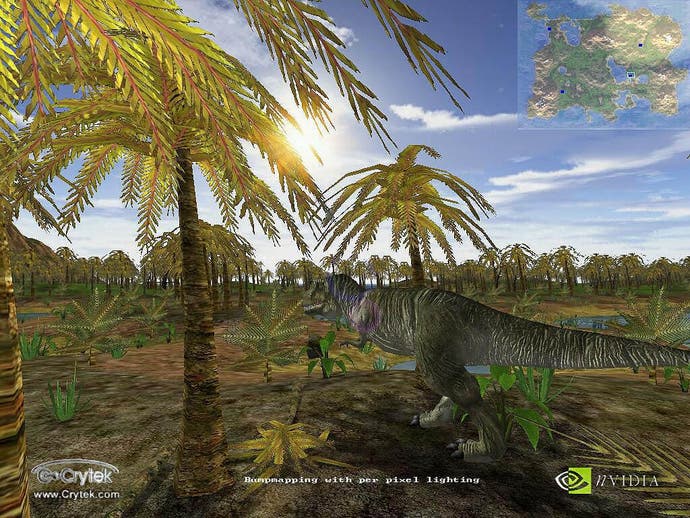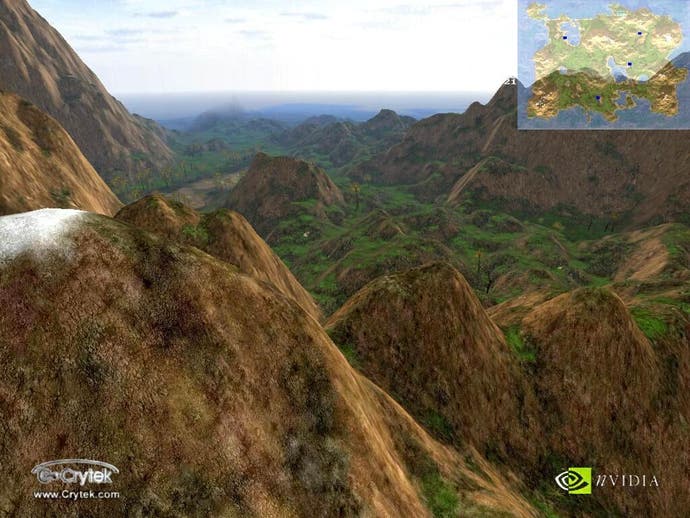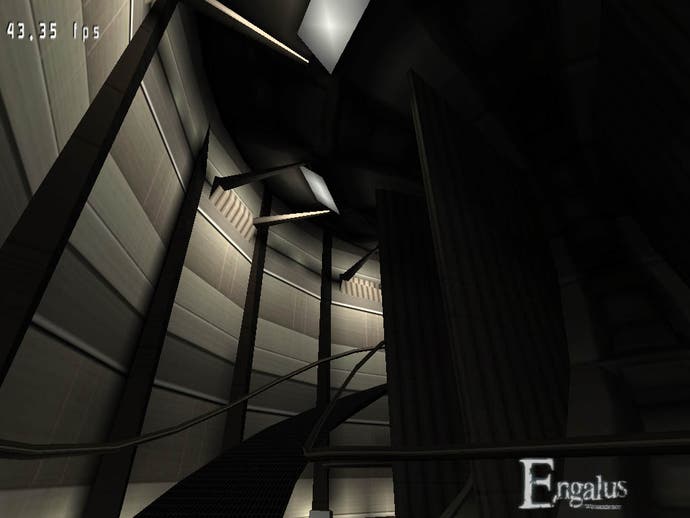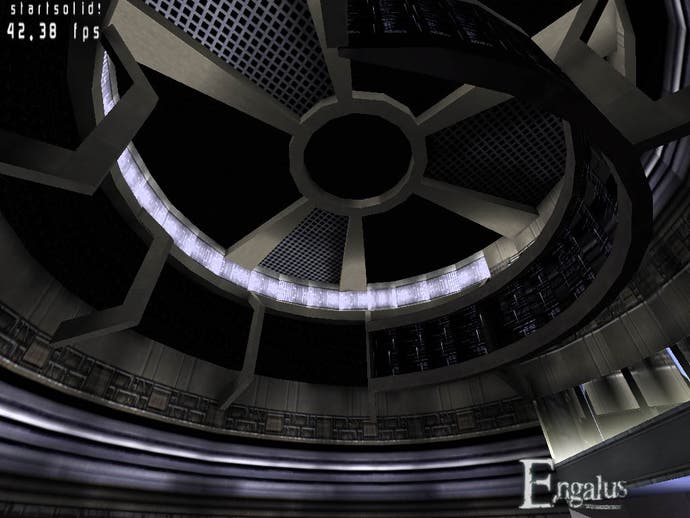Crytek Studios
Interview - we talk to the team behind the impressive tech demo used by NVIDIA to showcase their GeForce 2 Ultra at ECTS
Some of the most impressive games at the ECTS trade show in London were to be found on NVIDIA's stand, running on their latest GeForce 2 Ultra and GeForce 2 MX graphics cards. Codemasters dropped by with Colin McRae Rally 2.0, Peter Molyneux stopped off to demonstrate Black & White, and Giants was running on a widescreen TV throughout the show. And amongst all these top titles was a tech demo designed by a small German company called Crytek Studios, showing off the capabilities of the GeForce 2 by rendering a vast island with a T-Rex wandering amongst its trees. Crytek are now using the CryEngine which powered that tech demo to develop two new games, and we caught up with them to find out more...

In The Beginning
Crytek is a relatively new company, formed about eighteen months ago at the start of 1999. "Our Idea was to create an Internet based team to develop games", Faruk Yerli explained. "Because we are hardcore gamers, we found that most games had some weaknesses in their features, gameplay or graphics. So we started to do it in a better way, and Crytek was born!" Over the next year they worked on a cutting edge 3D game engine, eventually unveiling it at the massive E3 trade show in Los Angeles earlier this year. And it was there that Crytek met NVIDIA. "We showed them our Indoor Engine and our X-iSLE Demo. They were so fascinated with the polygon throughput we had at this time that they asked us to do a demo for their NV16 chip." This is the demo that we saw at ECTS, and it seems like we weren't the only people to be impressed by it either. "We got a lot of positive feedback from publishers, other developers, and hardware suppliers (especially AMD)", Faruk told us, going on to explain just why the engine raised so many eyebrows. "We never say that our engine is much better than others, but we have reached a polygon throughput which has never been reached before. Our engine can handle all kind of scenarios - it's fully scalable [and has] all the features of the Quake III engine, as well as the full support of NVIDIA's NV15 and NV16 chips and the next generation of NVIDIA and Xbox." Speaking of which, Crytek aren't limiting their ambitions to the PC. Next generation console versions of their engine are also planned, with specially optimised ports for all the main runners - Playstation 2, GameCube, and of course the Xbox, which is based around an NVIDIA graphics chip.

The Land That Time Forgot
The first of Crytek's games to be based around the engine is X-Isle, which forms the basis for the NVIDIA tech demo used at ECTS, pitting you against a mixture of high tech reptilian aliens and good old fashioned dinosaurs on a string of Pacific islands which were hidden from view by some sort of alien cloaking device. "The idea for X-Isle came from my brother, our CEO Cevat. In former times we watched almost every dinosaur film, and Cevat especially was a great fan of these animals. After picking the best features and elements from the films and documents in addition with our fantasies, we created the Project X-ISLE, and from this beginning X-ISLE was born. The plot involves aliens being exiled from their home planet, arriving on Earth, and recreating the extinct dinosaurs as warriors for their cause. The player's task is to remove them from the islands they occupy." It might sound like a standard sci-fi dinosaur blasting exercise, but as lead designer Tony Davis explained to us, there's more to it than that. "The game is different from others in that it is not rigidly mission based. The player chooses which island to investigate next, finding out the purpose of the alien structures built on them, and how to use them to their advantage. The islands are also linked - to exploit the defence system on one island might require shutting down the power on another." The result is a mixture of puzzle solving and out-and-out action in a massive freeform 3D environment, with an array of deadly weapons to entertain yourself with. "The game is set in 2010, so the weapons used by the humans are advanced forms of the ones used now, although alien technology can be picked up and used too."

The Devil's In The Details
The other game currently under development at Crytek is "Engalus", and lead designer Brian J.Audette took time out to tell us a little about the game... "I think I would have to cite Deus Ex when describing Engalus - that type of action / role-playing gameplay is really what we're shooting for". "We're definitely going to take things to a new level however, and really concentrate on creating a convincing game world. I always find myself going through games and saying 'wouldn't it be cool if they did this...' I don't want people to say that about our games, and in order to make sure of that we're going to scour every inch of the game and try to jam in as much content as we can conceive. Engalus aims to go beyond normal gaming and become a real experience, like being in the world of a great sci-fi movie. Paying attention to little details in every aspect of the game is key to this and that what Engalus is about .. details." The details of the game's plot are still being nailed down, but so far it goes something like this. "Engalus takes place in the 22nd century, about 50 years after World War 3. Earth has adopted more socialist ideals and is experiencing an age of unrivaled peace. In order to facilitate the propagation of these ideals across the planet and maintain the strength of the world community, the Provisional Government was formed, but it should have been dissolved some time before the game begins. Being the only real power structure puts the Provisional Government in a position to exert great control over the people without them even knowing." Your character is Jordain, "an operative for the Provisional Government who basically does their dirty work, ensuring that the people don't know too much about their corrupt overseers, and putting out any fires along the way". The game begins with Jordain being called in to investigate The Invisible, a group of outcasts accused of stealing some high-tech scientific equipment. "Obviously it ends up being more than simple theft, and Jordain gets involved in a plot of deception and betrayal surrounding an artifact called the Engalus, once possessed by an alien race know as the Lahorans". "To say much more would be giving too much away, but I can say that Jordain will find a lot of interesting people and situations on the Invisible's space station, which is more like a space-bound city than a simple satellite. The story is about power and corruption and what drives these forces, and how heroes can be found in the most unlikely places. It should be action packed with lots of great plot to make it a true experience."

Kino
One of the main aims of Engalus is to give it a more cinematic feel. "Really good filmmakers take into account everything that is in the frame for a given shot, from the most prominent character to the smallest background object", Brian explained. "This is easy to do when you control the camera angles that people see, but in first person games the player is the camera for the most part." "One of the things we're aiming for in making Engalus more "cinematic" is to treat every map like a scene in a movie. Every inch of a level should have those little details, so that wherever the player looks he is in the scene, and because of that the experience is more convincing. We're probably going to be using some techniques with lighting and effects that you see in movies. For instance in the X-Files whenever Mulder and Scully are in the woods there is always a strange glow in the background which adds atmosphere. In a game you don't have to do this kind of thing because the player can move anywhere they want, but finding ways to do it will make the game more cinematic, which I think people will respond to well." "The cut-scenes seen in game will be painstakingly done in a film style. Personally I'm tired of circling cameras and pointlessly awkward angles in game cutscenes. Things like cutaways, close-ups, two shots, pans and cranes are needed if the cut is to be interesting. A great example from recent games is the intro to Deus Ex - that is an absolutely beautiful piece of machinima. There's some other things we are toying with, like cutting away from action briefly while playing to show NPC reactions, or cool slow-mo shots but some of those are things we need to test before we can be sure." "The whole point of stressing cinematic style is to keep the player interested. I believe that adding these elements will create a more dynamic world that is harder to walk away from, and more fun to be in."

Conclusion
Crytek certainly have high ambitions, and Faruk told us that "we hope we will play a major role in 3D games in the future - our aim is to set standards in 3D technologies, and to be one of the coolest game developers in the world." It might sound optimistic, but if their gameplay can match their incredible looking technology, they just might achieve those ambitious aims. Hopefully we should know more next year as their games get further into development, but in the meantime best of luck to them.







